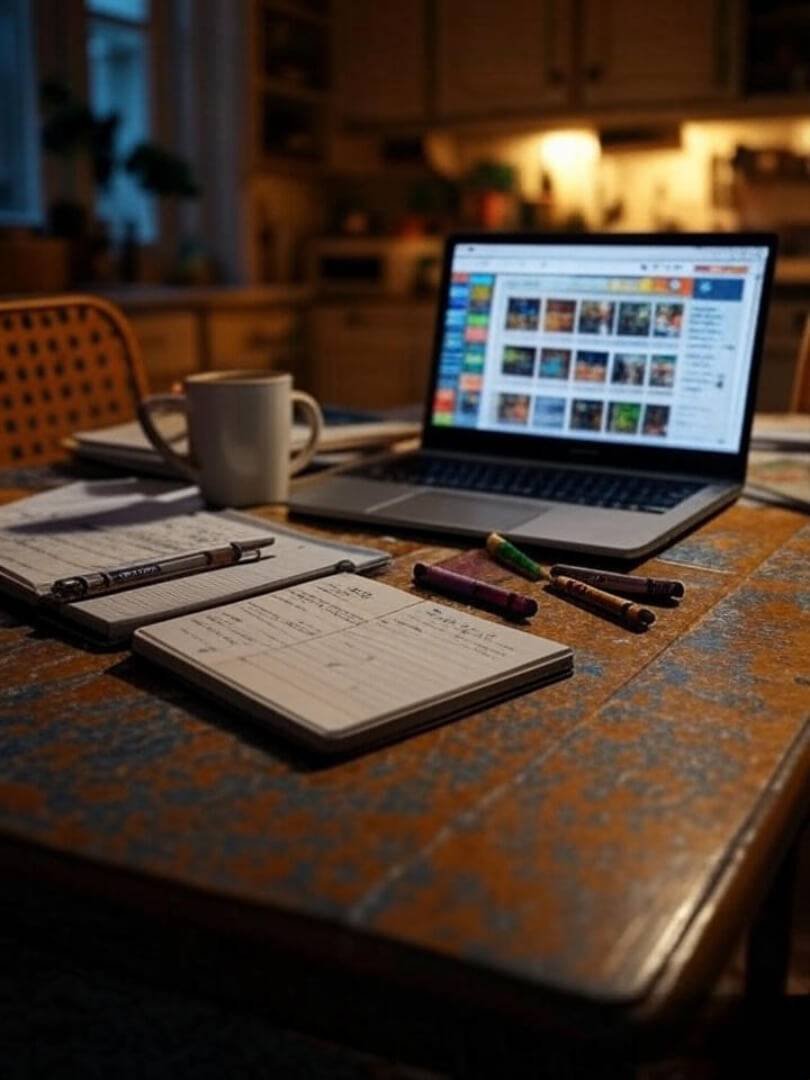Weekly planning…….You ever get to Sunday night and feel like you just got spit out of a washing machine? Like, where did the week go, why is my laundry still in the basket, and how is it Monday again already? Yeah. That was me—basically every week—for years.
Then I discovered weekly planning. Not in a Pinterest-perfect bullet journal with pastel highlighters (though props to those people, honestly, they’re doing the Lord’s work). I mean, just a messy, “I’ve got three kids, a job, and a Queens subway commute that’s always late” type of system. And the wild thing? It works.
So here’s the deal: this is my simple system to get more done without burning out. And if you’re rolling your eyes thinking, “Yeah, sure, another productivity hack,”—I get it. I used to hate this stuff. But stick with me, because this one’s actually doable.
How I accidentally found my groove
Flashback: I’m sitting at my kitchen table in Queens, half-drinking cold coffee (because my kid distracted me mid-sip), scrolling my inbox like a zombie. Suddenly I realize I’ve got three deadlines, a birthday party to plan, and my mom texting me about picking up paneer from Jackson Heights.

That week? Total chaos. I missed a meeting, I forgot to send my kid’s permission slip back to school, and I double-booked myself for dinner and a client call. I literally told my friend, “I’ll be there by 7,” while also logging into Zoom at 7. Legendary multitasking fail.
So I tried something new: Sunday night, I grabbed a notebook (not fancy, just one of those spiral ones with doodles on the cover), and I dumped every single thing in my brain onto paper. Work stuff, life stuff, even dumb stuff like “buy toothpaste.” Then I tried sorting it out into a plan.
That was the first week I didn’t feel like I was drowning.
The actual system (messy but effective)
So here’s how I do weekly planning now. It’s simple, I promise:
Step 1: Brain dump Sunday
Sit down, no distractions (except maybe snacks), and write everything on your mind. Appointments, projects, groceries, random things like “call dentist” or “figure out why the fridge smells weird.” Doesn’t matter. If it’s in your head, put it down.
Step 2: Pick 3 “non-negotiables”
This is the secret sauce. Every week, I choose 3 things that have to happen. Not 30. Not 15. Just 3. If I get those done, the week’s a win. Example: finish work presentation, take kids to the park once, and meal prep at least two dinners. That’s it.
Step 3: Assign days—but lightly
I don’t schedule down to the minute (because life in Queens doesn’t care about your color-coded calendar). Instead, I roughly block out days. Like:
- Monday: big work tasks
- Tuesday: errands
- Wednesday: flex buffer (aka: for stuff that explodes)
- Thursday: social/family stuff
- Friday: wrap-up + pizza night (non-negotiable, obviously)

Step 4: Leave space for chaos
Because chaos will happen. Someone will get sick, the subway will stop underground for 40 minutes, or your boss will say “quick question” and it turns into a 2-hour meeting. I don’t fight it anymore. I just plan with wiggle room.
Step 5: Friday reset
Friday afternoon, before I mentally check out and order a large pepperoni, I do a quick reset: what got done, what didn’t, what rolls into next week. Takes 10 minutes, saves me 10 headaches.
The burnout trap (and how I crawled out)
I used to think burnout meant working 90 hours a week like some finance bro in Manhattan. Turns out, you can burn out just as fast juggling PTA emails, project deadlines, and trying to keep up with the group chat that never stops buzzing.
Weekly planning stopped me from feeling like I was constantly chasing my own tail. When I can see the week laid out, I’m not panicking every morning thinking, “What did I forget?”
And here’s the kicker: it actually gives me more free time. Like guilt-free Netflix binges or random walks in Flushing Meadows. Because I know my 3 non-negotiables are handled.
My embarrassing “too much planning” story
Okay, real talk. One time, I went all-in on planning. Bought a fancy $60 planner (don’t ask why), got special pens, even stickers. I made this gorgeous spread with little doodles and boxes.
By Wednesday, it was destroyed. Coffee stains, sticky notes falling out, and my kid had drawn Spider-Man across half of it. I gave up.
Lesson learned: keep it simple. Weekly planning isn’t about making it pretty—it’s about making it work for your life.
A sample “normal person” weekly plan
Here’s what mine looked like last week (unedited, messy handwriting and all):
Non-negotiables:
- Finish website draft for client
- Call ConEd about bill (ugh)
- Family movie night Friday
Rough week flow:
- Monday: client draft, laundry
- Tuesday: groceries, school pickup swap with wife
- Wednesday: flex day (ended up at urgent care because my son stuck a bead in his nose… don’t ask)
- Thursday: work meeting marathon
- Friday: wrap up, pizza + Inside Out 2 with the kids
And guess what? Even with the bead-nose emergency, the week felt fine. Because I planned space for the unexpected.
The magic isn’t in the planner—it’s in the perspective
Weekly planning doesn’t make life perfect. You’ll still have curveballs. But it gives you this weird calmness, like, “Okay, the world’s a mess, but I know my top 3. I’m good.”
And when you do it consistently, you notice stuff. Like, “Wow, I actually am making progress,” instead of feeling like you’re just spinning your wheels.
Wanna try it? Start this Sunday
Here’s your lazy starter version:
- Write down everything on your brain.
- Pick 3 things that matter most this week.
- Spread out the rest loosely across the days.
- Leave space for chaos.
- Friday reset.
That’s it. You’re now “planning like a pro.” No stickers required.
Final rambly thought
Look, I’m not a productivity guru. I live in Queens, my apartment’s too small, and my to-do list still sometimes makes me want to cry. But this weekly planning thing? It’s the only system that’s actually stuck for me.
So if you’re tired of burning out and you want to feel like you’re running your week instead of it running you—give it a shot. Worst case, you waste 20 minutes on a Sunday. Best case? You get your life back.
And hey—if you ever find a way to plan so well that kids stop sticking beads in their noses, please DM me immediately.



